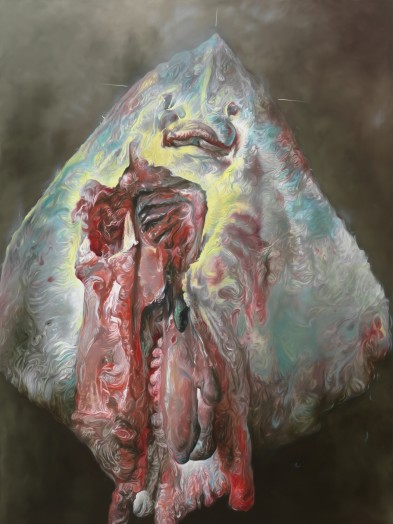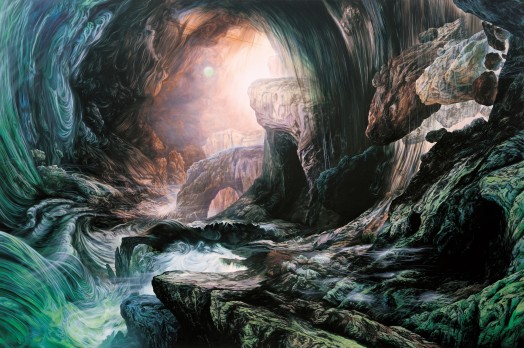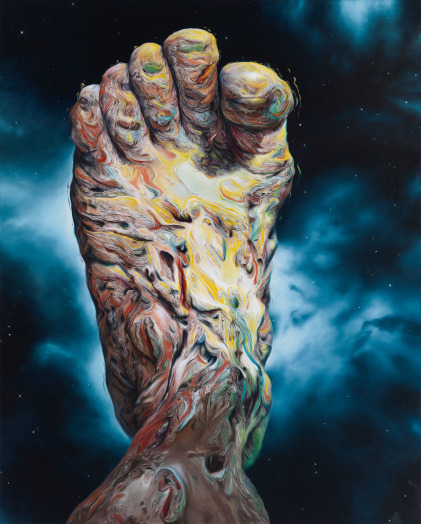Beyond Reality: Galerie Rudolfinum, Prague, Czech Republic
A selection of Glenn Brown paintings were shown in Pargue in 2012.
In general, reflecting on reality by way of depicting it is the essential premise of painting. The form, method, content of and motivation for any one rendering come one step, if not more, behind. Yet the question today is not whether one can render reality real, as there exists a plethora of ways to effectively deal with this challenge, the question is rather why create such paintings in the first place. Furthermore, what is important is the decision regarding what segments of reality, be they tangible, visible or merely conceivable, can indeed be rendered. There are many paths to follow when handling such a task. One of them takes a painter just to the surface of things and its most faithful rendering. Another is a path wading through a tangled web of references to antecedent paintings and their contexts, which allows for an unbelievable combinatorics of facts and myths to be incessantly interwoven and elaborated on. Both of these paths have their own laws, limitations and charms.
The paintings of the twelve contemporary British artists give their outstanding and idiosyncratic takes on the above questions. The exhibition, specially designed for the distinct space of the Rudolfinum, presents a specially-composed and interconnected selection of artworks produced over the course of approximately the past ten years. The exhibition has its own inner story, it being unfolded linearly and divided into two groups of different sizes. Staged in the first, larger group are the works by artists Jason Brooks, Hynek Martinec, Ben Johnson, Keith Tyson, Marie Harnett, Jonathan Wateridge and Damien Hirst. All of these artists seek to grasp reality through a smooth surface of veristic painting, which admittedly draws from photography. That way they are able to work their way into fiction - the illusory world of discontinuous realities, of which the one on the surface, despite all of its traceable links to a particular situated reality, is also a gateway or window into a timeless world with an evocative power that goes on splintering off the possible allusions to the here-and-now. Clearly, the invention of photography had largely rid painting of the historical need to grapple with the reality as we see it, the need to constantly come full circle in return to narrative realism in striving for as faithful a rendering as possible. On the other hand, it is thanks to photography that what came to the fore was painting as an independent quality, able to bear many a meaning which could not be achieved or accentuated using other rendering methods.
Work on a painting´s reality - i.e. with a work of art being the initial subject matter and stimulus for a motivic combinatorics resulting in multiple-layer accounts with a rich matrix of references to various layers of Europe´s cultural memory - is based on the firm belief in a shared and ever intelligible content of highly-informed painting; painting which is firmly ingrained in Europe´s tradition of pictorial work, employing ancient allusions evolved over the centuries, aided by a whole apparatus of stories, myths, richly structured iconographic patterns and narrative practices alike. Regarding the creative work of the second group of artists, i.e. Glenn Brown, Ged Quinn, Mathew Weir as well as Jake and Dinos Chapman, the key is the bond to the past along the fundamental axis of prevailing values, which once connected to the present day come alive and become enriched by further contexts. To draw from the history of European painting is to touch upon classical painting, which had worked not on the basis of realism or efforts to faithfully render the world as is, rather it had captured and constituted thinking about the world by rendering some relatively sharp observations of reality´s fragments.
All of the participating artists employ the layering of a painting´s reality, a richness of the contextual framework, different painting techniques, oftentimes a very sophisticated structure of references and meanings possessing ingenuity worthy of a Persian miniature painter. All of them work on paintings believing the history of art can be continued, being aware of the validity of a rendering act as such on a - thus far - uninterrupted axis of its historical evolution. Virtually all of the artists included in this exhibition shape up in their studios paintings of a new reality that, with the paintings´ credibility lent by high-quality, largely illusionary artistry, not only does it faithfully imitate reality, but through the very fidelity grants an insight and invites into a world beyond reality. A world that may be imaginary, perceived, but often witnessed either in a dream, in everyday reality, or perhaps in an ancient art gallery; a world that possesses more than just the superficial dimension of a mechanically depicted surface simply offered for consumption; a world that is often a very complex, intellectual construct nurtured by creative thinking about the world and one providing room and incentives for richly-structured thinking about reality both in its particulars and in wholes, and about the possibilities of transcending it.
The exhibition is mounted at Galerie Rudolfinum in Prague, running from 4 October to 30 December 2012. An exhibition catalogue will be released containing essays penned by Milena Slavická, who had authored the original concept of the exhibition, and by the exhibition’s curator Petr Nedoma. The catalogue will also include a generous supplement with many of the exhibited works.
Alongside the exhibition, Galerie Rudolfinum´s education department is preparing to offer a series of accompanying programmes and resources, namely informative content produced by curators and art historians, as well as the artists´ personal accounts. Separately, an educational programme for schools of all levels will be organised, which will include worksheets, workshops and lectures at the exhibition.
Participating artists:
Jason Brooks, Glenn Brown, Jake & Dinos Chapman, Marie Harnett, Damien Hirst, Ben Johnson, Hynek Martinec, Ged Quinn, Keith Tyson, Jonathan Wateridge, Mathew Weir
Exhibition idea: Milena Slavická
Exhibition curator: Petr Nedoma




